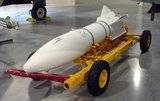Raptor
Administrator


Posts : 31
Joined : 2010-01-15
Age : 36
Gender : 
Location : India
 |  Subject: AIR 2 Genie Subject: AIR 2 Genie  Thu Jan 21, 2010 11:01 am Thu Jan 21, 2010 11:01 am | |
| AIR 2 GENIE ------------------------------------------------------------------------------------------------------------------------------------------------------------------- SPECIFICATIONS :Length : 2.95 m (9 ft 8 in)
Diameter : 0.44 m (17.5 in)
Wingspan : 1.02 m (3 ft 4 in)
Launch weight : 373 kg (822 lb)
Speed : Mach 3.3
Range : 9.6 km (6 mi)
Guidance : Inertial (None)
Warhead : W25 nuclear fission, 1.5 kiloton yield
Date deployed : 1957
Date retired : 1985
-------------------------------------------------------------------------------------------------------------------------------------------------------------------- BACKGROUND The Douglas AIR-2 Genie (previous designation MB-1) was an unguided air-to-air rocket with a 1.5kt W25 nuclear warhead. It was deployed by the United States Air Force (USAF) (from 1957) and the Canadian Forces Air Command (from 1965 to 1984)[1] during the Cold War. Production ended in 1962 after over 3000 were produced, with some related training and test derivatives occurring later.-------------------------------------------------------------------------------------------------------------------------------------------------------------------- DESIGN The interception of Soviet bombers was a major military preoccupation of the late 1940s and 1950s. The revelation in 1947 that the Soviet Union had produced a reverse-engineered copy of the Boeing B-29 Superfortress, the Tupolev Tu-4 (NATO reporting name 'Bull'), which could reach the continental United States in a one-way attack, followed by the Soviets developing their own atomic bomb in 1949, produced considerable anxiety.
The World War II-vintage fighter armament of machine guns and cannon were inadequate to stop attacks by massed formations of high-speed bombers. Firing large volleys of unguided rockets into bomber formations was not much better, and true air-to-air missiles were in their infancy. In 1954 Douglas Aircraft began a program to investigate the possibility of a nuclear-armed air-to-air weapon. To ensure simplicity and reliability, the weapon would be unguided, the large blast radius making accuracy mostly irrelevant.
The resultant weapon carried a 1.5-kiloton W25 nuclear warhead and was powered by a Thiokol SR49-TC-1 solid-fuel rocket engine of 162 kN (36,500 lbf) thrust. It had a range of slightly under 10 km (6.2 mi). Targeting, arming, and firing of the weapon were coordinated by the launch aircraft's fire-control system. Detonation was by time-delay fuze, although the fuzing mechanism would not arm the warhead until engine burn-out, to give the launch aircraft sufficient time to turn and escape. Lethal radius of the blast was estimated to be about 300 meters (1,000 ft).
The first test firings of inert rounds took place in 1956, and the weapon entered service with the designation MB-1 in 1957. The popular name was Genie, but it was often nick-named 'Ding-Dong.' About 3,150 rounds were produced before production ended in 1963. In 1962 the weapon was redesignated AIR-2A Genie. Many rounds were upgraded with improved, longer-duration rocket motors, the upgraded weapons sometimes known (apparently only semi-officially) as AIR-2B. An inert training round, originally MB-1-T and later ATR-2A, was also produced in small numbers.
A live Genie was detonated only once, in Operation Plumbbob on 19 July 1957. It was fired by AF Captain Eric William Hutchison (pilot) and AF Captain Alfred C. Barbee (radar operator) flying a F-89J over Yucca Flats at an altitude of 4,500 m (15,000 ft). A group of five USAF officers volunteered to stand hatless in their light summer uniforms underneath the blast to prove that the weapon was safe for use over populated areas. They were photographed by George Yoshitake who stood there with them. Gamma and neutron doses received by observers on the ground were negligible. Doses received by aircrew were highest for the fliers assigned to penetrate the airburst cloud ten minutes after explosion.
The Genie was cleared to be carried on the F-89 Scorpion, F-101B Voodoo, F-106 Delta Dart, and F-104 Starfighter in U.S. service. However, the Starfighter never carried it in operational service. Convair offered an upgrade of the F-102 Delta Dagger that would have been Genie-capable, but it was not adopted. Operational use of the Genie was discontinued in 1988 with the retirement of the F-106 interceptor.
The only non-U.S. user was Canada, whose CF-101 Voodoos carried Genies until 1984 via a dual-key arrangement where the missiles were kept under American custody, and released to Canada under circumstances requiring their use. The RAF briefly considered the missile for use on the English Electric Lightning.
Safety features included final arming by detecting the acceleration and deceleration of a fast aircraft at high altitude. The weapon was built too early to use a permissive action link security device.
The F-89J that was used to launch the only live test is on static display at the Montana Air National Guard in Great Falls, MT.-------------------------------------------------------------------------------------------------------------------------------------------------------------------- IMAGE GALLERY  .  .  .   .  .  .  | |
|
